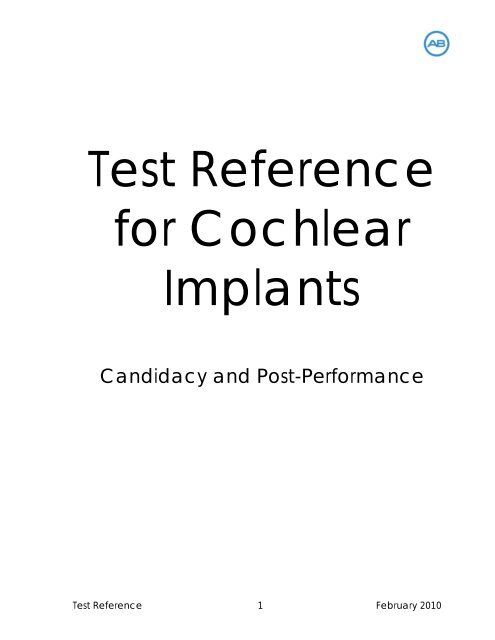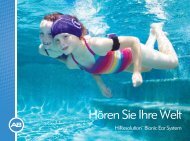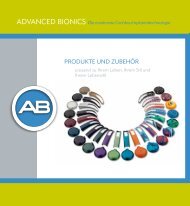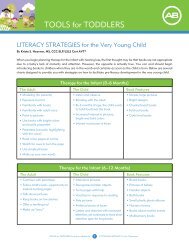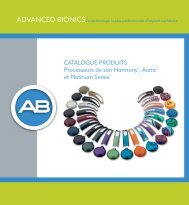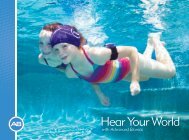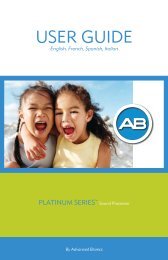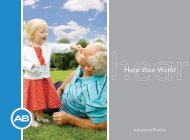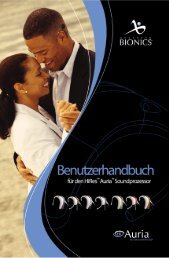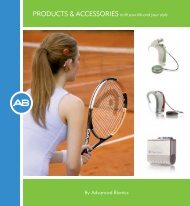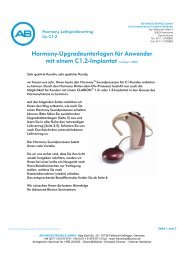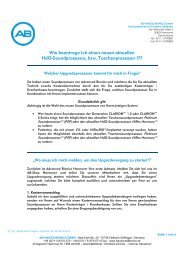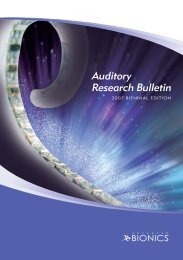Test Reference for Cochlear Implants - The ... - Advanced Bionics
Test Reference for Cochlear Implants - The ... - Advanced Bionics
Test Reference for Cochlear Implants - The ... - Advanced Bionics
Create successful ePaper yourself
Turn your PDF publications into a flip-book with our unique Google optimized e-Paper software.
<strong>Test</strong> <strong>Reference</strong><br />
<strong>for</strong> <strong>Cochlear</strong><br />
<strong>Implants</strong><br />
Candidacy and Post-Per<strong>for</strong>mance<br />
<strong>Test</strong> <strong>Reference</strong> 1 February 2010
Introduction<br />
Assessment tools are an integral component when providing clinical<br />
services related to cochlear implants. Whether working with a<br />
potential cochlear implant candidate or a long-time cochlear<br />
implant recipient, evaluations are a part of the process. This <strong>Test</strong><br />
<strong>Reference</strong> is intended to provide resources <strong>for</strong> audiologic<br />
assessment with both the pediatric and adult populations.<br />
In<strong>for</strong>mation about speech and language evaluation tools is<br />
provided as well. This <strong>Test</strong> <strong>Reference</strong> is not intended to be allinclusive,<br />
but to include in<strong>for</strong>mation about some of the most<br />
commonly used assessments. Feedback about this document is<br />
welcome and can be sent to<br />
Education.Training@<strong>Advanced</strong><strong>Bionics</strong>.com.<br />
<strong>Test</strong> <strong>Reference</strong> 2 February 2010
Index<br />
<strong>Test</strong> Page<br />
Adult Auditory Perception Assessments<br />
AZ Bio Sentences 5<br />
Bam<strong>for</strong>d-Kowal-Bench Sentence In Noise <strong>Test</strong> (BKB-SIN) 5<br />
Cali<strong>for</strong>nia Consonant <strong>Test</strong> 6<br />
City University of New York (CUNY) Sentences 6<br />
Consonant Nucleus Consonant (CNC) <strong>Test</strong> 6<br />
Hearing in Noise <strong>Test</strong> (HINT) Pro 7<br />
Iowa Sound Quality <strong>Test</strong> 7<br />
Ling Six Sound <strong>Test</strong> 7<br />
Minimal Audible Capabilities (MAC) Battery 8<br />
QuickSIN 8<br />
Sentence in Noise (SIN) <strong>Test</strong> 9<br />
Speech Hearing, Spatial Hearing and Quality of Hearing Questionnaire (SSQ) 9<br />
Pediatric Auditory Perception Assessments<br />
Auditory Behavior in Everday Life (ABEL) 10<br />
Auditory Perception of Alphabet Letters (APAL) 10<br />
Bam<strong>for</strong>d-Kowal-Bench Sentence In Noise <strong>Test</strong> (BKB-SIN) 11<br />
Bilingual Family Interview (BIFI) 11<br />
Cali<strong>for</strong>nia Consonant <strong>Test</strong> 12<br />
Children’s Auditory Per<strong>for</strong>mance Scale (CHAPS) 12<br />
Children’s Home Inventory <strong>for</strong> Listening Difficulties (CHILD) 13<br />
Children’s Realistic Index of Speech Perception (CRISP) 13<br />
Common Phrases <strong>Test</strong> 13<br />
Consonant Nucleus Consonant (CNC) <strong>Test</strong> 14<br />
Cottage Acquisition Scales <strong>for</strong> Listening, Language & Speech (CASLLS) 14<br />
Early Listening Function (ELF) 14<br />
Early Speech Perception <strong>Test</strong> (ESP) 15<br />
Functional Auditory Per<strong>for</strong>mance Indicators (FAPI) 15<br />
Functioning After Pediatric <strong>Cochlear</strong> Implantation (FAPCI) 16<br />
Goldman-Fristoe-Woodcock <strong>Test</strong> of Auditory Discrimination 16<br />
Hearing in Noise <strong>Test</strong> <strong>for</strong> Children (HINT-C) 16<br />
Infant-Toddler: Meaningful Auditory Integration Scale (IT-MAIS) 17<br />
Iowa Sound Quality <strong>Test</strong> 17<br />
Lexical Neighborhood <strong>Test</strong> (LNT) 18<br />
Ling Six Sound <strong>Test</strong> 18<br />
Listening Inventory <strong>for</strong> Education (LIFE) 18<br />
Meaningful Auditory Integration Scale (MAIS) 19<br />
Meaningful Use of Speech Scale (MUSS) 19<br />
Minimal Pairs <strong>Test</strong> 20<br />
Mr. Potato Head Task 20<br />
Multi-syllabic Lexical Neighborhood <strong>Test</strong> (MLNT) 21<br />
<strong>Test</strong> <strong>Reference</strong> 3 February 2010
<strong>Test</strong> Page<br />
Pediatric Auditory Perception Assessments (cont.)<br />
Northwestern University – Children’s Perception of Speech (NU-CHIPS) 21<br />
Pediatric Speech Intelligibility <strong>Test</strong> (PSI) 22<br />
Phonetically Balanced Kindergarten <strong>Test</strong> (PBK-50) 22<br />
Speech Perception Instructional Curriculum and Evaluation (SPICE) 23<br />
Teachers’ Evaluation of Aural/Oral Per<strong>for</strong>mance in Children (TEACH) 23<br />
<strong>Test</strong> <strong>for</strong> Auditory Comprehension of Language – Third Edition (TACL-R) 24<br />
<strong>Test</strong> <strong>for</strong> Auditory-Perceptual Skills – Revised (TAPS-R) 25<br />
Word Intelligibility by Picture Identification (WIPI) 25<br />
Speech and Language Assessments<br />
Arizona Articulation Proficiency Scale – Third Edition 26<br />
Bracken School Readiness Assessment – Third Edition (BSRA-3) 26<br />
Clinical Evaluation of Language Fundamentals (CELF-4) 27<br />
Clinical Evaluation of Language Fundamentals - Preschool 2 (CELF-P2) 27<br />
Comprehensive Assessment of Spoken Language (CASL) 28<br />
Communication and Symbolic Behavior Scales (CSBS) 28<br />
Cottage Acquisition Scales <strong>for</strong> Listening, Language and Speech (CASLLS) 29<br />
Expressive One-Word Picture Vocabulary <strong>Test</strong> (EOWPVT) 29<br />
Expressive Vocabulary <strong>Test</strong> (EVT) 30<br />
Expressive Vocabulary <strong>Test</strong>-2 (EVT-2) 30<br />
Goldman-Fristoe <strong>Test</strong> of Articulation 31<br />
Hawaii Early Learning Profile (HELP) 31<br />
Hodson Assessment of Phonological Patterns – Third Edition (HAPP-3) 32<br />
<strong>The</strong> MacArthur-Bates Communicative Development Inventories 32<br />
Oral and Written Language Scales (OWLS) 33<br />
Peabody Picture Vocabulary <strong>Test</strong> (PPVT-IV) 34<br />
Preschool Language Scale (PLS-4) 34<br />
Preschool Screening Instrument <strong>for</strong> Targeting Educational Risk (Pre-SIFTER) 35<br />
Receptive One-Word Picture Vocabulary <strong>Test</strong> (ROWPVT) 35<br />
Receptive Expressive Emergent Language <strong>Test</strong> – Third Edition (REEL-3) 36<br />
Screening Instrument <strong>for</strong> Targeting Educational Risk (SIFTER) 36<br />
SKI-HI Language Development Scale 37<br />
Structured Photographic Expressive Language <strong>Test</strong> 3 (SPELT-3) 37<br />
Structured Photographic Expressive Language <strong>Test</strong> - Preschool 2 (SPELT-P 2) 38<br />
<strong>The</strong> Rosetti Infant-Toddler Language Scale 38<br />
Teacher Assessment of Spoken Language (TASL) 39<br />
<strong>Test</strong> of Semantic Skills – Primary (TOSS-P) 39<br />
<strong>Test</strong> <strong>Reference</strong> 4 February 2010
Adult Auditory Perception Assessments<br />
AZ Bio Sentences<br />
(Dorman and Spahr, 2004)<br />
Description: <strong>The</strong> AzBio Sentence Lists were created at Arizona State University<br />
and evaluate speech understanding. <strong>The</strong> sentence materials are available on<br />
an audio CD designed specifically <strong>for</strong> use with a clinical audiometer. Each CD<br />
contains 15 lists of 20 sentences, a soundfield calibration noise, and a 1000 Hz<br />
calibration tone. A 10-talker babble noise runs continuously on the second track<br />
of the CD. Score sheets are available <strong>for</strong> download as a printable pdf or as an<br />
Excel spreadsheet that allows inclusion of in<strong>for</strong>mation such as patient<br />
in<strong>for</strong>mation, sentence scores, and notes. <strong>The</strong> Excel version will automatically<br />
calculate percent correct scores.<br />
Order from:<br />
www.auditorypotential.com<br />
Bam<strong>for</strong>d-Kowal-Bench Sentence In Noise <strong>Test</strong> (BKB-SIN)<br />
(Etymotic Research, 2005)<br />
Description: <strong>The</strong> BKB-SIN uses 18 equivalent list pairs <strong>for</strong> estimating SNR loss.<br />
CD 1 (Standard BKB-SIN) has the target talker and background babble<br />
recorded on the same channel of the CD, at pre-recorded signal-to-noise ratios.<br />
CD 2 (Split Track BKB-SIN) has the target talker and background babble<br />
recorded on separate channels of the CD. <strong>The</strong> BKB-SIN features Bam<strong>for</strong>d-Kowal-<br />
Bench sentences in four talker babble, uses less complex sentences than the<br />
QuickSIN, and has norms <strong>for</strong> children, adults, and cochlear implant users.<br />
Order from:<br />
Auditec of St. Louis<br />
2515 South Big Bend Blvd.<br />
St. Louis, MO 63143<br />
(800)669-9065 or (314)781-8890 (phone)<br />
(314)781-4946 (fax)<br />
http://www.auditec.com<br />
or<br />
Etymotic<br />
61 Martin Lane<br />
Elk Grove Village, IL 60007<br />
(888)389-6684 (phone)<br />
http://www.etymotic.com<br />
<strong>Test</strong> <strong>Reference</strong> 5 February 2010
Cali<strong>for</strong>nia Consonant <strong>Test</strong><br />
(Owens and Schubert, 1977)<br />
Description: This is a closed-set, pencil/paper, multiple choice word recognition<br />
test. It consists of two 100-word lists. <strong>The</strong> CCT is particularly sensitive to high<br />
frequency hearing loss and is, there<strong>for</strong>e, considered to be useful in hearing aid<br />
evaluations. <strong>The</strong> first and second halves of list one are equivalent and, there<strong>for</strong>e,<br />
half lists can be given with confidence. This is not true of list two, however.<br />
Order from:<br />
Auditec of St. Louis<br />
2515 South Big Bend Blvd.<br />
St. Louis, MO 63143<br />
(800)669-9065 or (314)781-8890 (phone)<br />
(314)781-4946 (fax)<br />
http://www.auditec.com<br />
City University of New York (CUNY) Sentences<br />
Description: This test utilizes <strong>for</strong>ty recorded sets of 12 sentences. <strong>The</strong>se sentences<br />
vary in length and subject matter and are not designed specifically <strong>for</strong> word<br />
recognition.<br />
Order from:<br />
Auditec of St. Louis<br />
2515 South Big Bend Blvd.<br />
St. Louis, MO 63143<br />
(800)669-9065 or (314)781-8890 (phone)<br />
(314)781-4946 (fax)<br />
http://www.auditec.com<br />
Consonant Nucleus Consonant (CNC) <strong>Test</strong><br />
(Peterson and Lehiste, 1962)<br />
Description: This test was developed to provide lists of monosyllabic words with<br />
equal phonemic distribution across lists with each list exhibiting approximately<br />
the same phonemic distribution as the English language. <strong>The</strong> ten lists of 50 words<br />
contain monosyllabic words with a frequency of occurrence greater than four<br />
per million, as calculated in the Thorndike and Lorge word frequency tables.<br />
Order test materials from:<br />
Bio-logic Systems Corp.<br />
(800)323-8326 ext 239<br />
sales@bio-logic.com<br />
Download test <strong>for</strong>ms from:<br />
http://www.bionicear.com/For_Professionals/Audiology_Support/CNC_<strong>Test</strong>.cfm?<br />
langid=1<br />
<strong>Test</strong> <strong>Reference</strong> 6 February 2010
Hearing in Noise <strong>Test</strong> (HINT) Pro<br />
Description: <strong>The</strong> HINT® Pro is a complete system <strong>for</strong> evaluating functional<br />
hearing in quiet and in noise. <strong>The</strong> system includes both hardware and software<br />
and requires a PC. It uses the HINT sentence materials that were previously<br />
available on a CD. <strong>The</strong> HINT Pro includes normative data so the patient's HINT<br />
scores can be compared to normal hearing individuals. <strong>The</strong> test can be<br />
administered via headphones using virtual audio sound processing that<br />
simulates the various conditions of noise front, noise right and noise left. It can<br />
also be administered through the sound field and is available in more than 12<br />
languages.<br />
Order from:<br />
Bio-logic Systems Corp.<br />
(800)323-8326 ext 239<br />
sales@bio-logic.com<br />
Iowa Sound Quality <strong>Test</strong><br />
(Tyler, 2003)<br />
Description: <strong>The</strong> Iowa Sound Quality <strong>Test</strong> consists of 6 categories of sounds: adult<br />
voices, children’s voices, everyday sounds, music, and speech in noise. Each<br />
category contains 16 sound samples <strong>for</strong> a total of 96 items. <strong>The</strong> subject listens to<br />
each randomly played sound, presented at 70 dB(C) SPL, emanating from a<br />
loudspeaker placed at 0 degrees azimuth. Using a computer touch screen, the<br />
subject rates the sound’s clarity ranging anywhere from zero (unclear) to 100<br />
(clear) by touching a visual analog scale that represents the perceived clarity of<br />
the sound.<br />
Order from:<br />
Rich Tyler<br />
rich-tyler@uiowa.edu<br />
Ling Six Sound <strong>Test</strong><br />
(Ling and Ling, 1978)<br />
Description: <strong>The</strong> sounds used in this test are the vowels /a/ as in art, /u/ as in who,<br />
and /i/ as in ease, and the consonants /m/ as in me, /S/ as in she and /s/ as in so.<br />
<strong>The</strong>se sounds are used because they include low-, mid-, and high frequency<br />
components of speech and ability to hear all six of these sounds implies ability to<br />
detect all other sounds of speech. <strong>The</strong> ability to detect and discriminate these<br />
phonemes is evaluated in an auditory only, open-set <strong>for</strong>mat.<br />
Download instructions and test cards from:<br />
http://www.advancedbionics.com/For_Professionals/Audiology_Support/Ling_Si<br />
x_Sound_<strong>Test</strong>.cfm?langid=1<br />
<strong>Test</strong> <strong>Reference</strong> 7 February 2010
Minimal Audible Capabilities (MAC) Battery<br />
(Owens, Kessler, Telleen, and Schubert, 1981)<br />
Description: <strong>The</strong> Minimal Auditory Capabilities (MAC) battery is specifically<br />
targeted to the cochlear implant patient. It consists of a series of tasks which are<br />
graded in difficulty. Most of the MAC battery sub-tests assume that a patient’s<br />
hearing loss has occurred post-lingual, but it can be employed as a means of<br />
evaluating the hearing abilities of persons <strong>for</strong> whom traditional speech materials<br />
are too difficult. <strong>The</strong> recorded materials include gross sound identification,<br />
inflection detection, contrast detection, accent discrimination, and word<br />
identification.<br />
Order from:<br />
Auditec of St. Louis<br />
2515 South Big Bend Blvd.<br />
St. Louis, MO 63143<br />
(800)669-9065 or 314-781-8890 (phone)<br />
(314)781-4946 (fax)<br />
http://www.auditec.com<br />
QuickSIN<br />
(Etymotic Research, 2001)<br />
Description: This is a modification of the SIN and, as the title suggests, is a shorter<br />
version of the SIN. <strong>The</strong> lists are equivalent to those in the SIN and provide a quick<br />
and accurate assessment of patient per<strong>for</strong>mance. It is available on CD only.<br />
Order from:<br />
Auditec of St. Louis<br />
2515 South Big Bend Blvd.<br />
St. Louis, MO 63143<br />
(800)669-9065 or (314)781-8890 (phone)<br />
(314)781-4946 (fax)<br />
http://www.auditec.com<br />
or<br />
Etymotic Research<br />
61 Martin Lane<br />
Elk Grove Village, IL 60007<br />
(888)389-6684 (phone)<br />
http://www.etymotic.com<br />
<strong>Test</strong> <strong>Reference</strong> 8 February 2010
Sentence in Noise <strong>Test</strong> (SIN)<br />
(Killion and Villchur, 1993)<br />
Description: <strong>The</strong> Speech in Noise (SIN) test was developed to help determine<br />
how much a hearing prosthesis benefits an individual’s speech understanding in<br />
background of noise. <strong>The</strong> test consists of a series of female-talker recordings of<br />
the IEEE sentences as the target speech, and four-talker babble as the noise<br />
source. Five sentences are recorded at each of four signal-to-noise (S/N) ratios:<br />
15 dB, 10 dB, 5 dB and 0 dB S/N, followed by a similar series recorded at a signal<br />
level 30 dB lower than the calibration level. <strong>The</strong>re<strong>for</strong>e, there are 20 sentences at<br />
each level <strong>for</strong> a total of 40 sentences (or 4 IEEE lists), all of which constitutes a<br />
block.<br />
Order from:<br />
Auditec of St. Louis<br />
2515 South Big Bend Blvd.<br />
St. Louis, MO 63143<br />
(800)669-9065 or (314)781-8890 (phone)<br />
(314)781-4946 (fax)<br />
http://www.auditec.com<br />
or<br />
Etymotic Research<br />
61 Martin Lane<br />
Elk Grove Village, IL 60007<br />
(888)389-6684 (phone)<br />
http://www.etymotic.com<br />
Speech Hearing, Spatial Hearing, and Quality of Hearing<br />
Questionnaire (SSQ)<br />
(Gatehouse and Noble, 2004)<br />
Description: <strong>The</strong> SSQ is a questionnaire that was developed to measure<br />
influences of cochlear function on auditory disability and handicap. It is<br />
designed to be administered by interview instead of by self-assessment. <strong>The</strong>re<br />
are 80 questions about auditory attention, perceptions of distance and<br />
movement, sound-source segregation, listening ef<strong>for</strong>t, prosody and sound<br />
quality<br />
Download from MRC Institute of Hearing Research at:<br />
http://www.ihr.mrc.ac.uk/products/index.php?page=questionnaire_downloads<br />
<strong>Test</strong> <strong>Reference</strong> 9 February 2010
Pediatric Auditory Perception Assessments<br />
Auditory Behaviour in Everday Life (ABEL)<br />
(Purdy et al., 2002)<br />
Recommended age: 2 years to 12 years<br />
Description: This is a thirty-five item questionnaire developed to assess parental<br />
perceptions of their children’s auditory behavior. <strong>The</strong> test addresses three<br />
subscales (Auditory Oral, Auditory Awareness, and Social/Conversational Skills).<br />
<strong>The</strong> subset of 24 questions can be utilized with children ages 2-3 if the child’s<br />
language skills are adequate.<br />
Questionnaire can be found in:<br />
Purdy, S., et al. 2002. ABEL: Auditory Behaviour in Everyday Life, American<br />
Journal of Audiology, 11:72-82<br />
Auditory Perception of Alphabet Letters (APAL)<br />
(Ross and Randolph, 1990)<br />
Recommended age: Minimum of 5 years<br />
Description: <strong>The</strong> Auditory Perception of Alphabet Letters (APAL) was developed<br />
<strong>for</strong> use with hearing impaired children <strong>for</strong> whom the more standard tests are<br />
unsuitable. Children may be unfamiliar with some of the pictured items on the<br />
WIPI, PSI, or NU-CHIPS, or some of the PBK-50 words may not be in the child’s<br />
vocabulary or the child’s speech may be unintelligible, or the materials may be<br />
too easy or uninteresting. In these cases the APAL may prove useful.<br />
Order from:<br />
Auditec of St. Louis<br />
2515 South Big Bend Blvd.<br />
St. Louis, MO 63143<br />
(800)669-9065 or (314)781-8890 (phone)<br />
(314)781-4946 (fax)<br />
http://www.auditec.com<br />
<strong>Test</strong> <strong>Reference</strong> 10 February 2010
Bam<strong>for</strong>d-Kowal-Bench Sentence In Noise <strong>Test</strong> (BKB-SIN)<br />
(Etymotic Research, 2005)<br />
Recommended age: Minimum of 5 years<br />
Description: <strong>The</strong> BKB-SIN uses 18 equivalent list pairs <strong>for</strong> estimating SNR loss.<br />
CD 1 (Standard BKB-SIN) has the target talker and background babble<br />
recorded on the same channel of the CD, at pre-recorded signal-to-noise ratios.<br />
CD 2 (Split Track BKB-SIN) has the target talker and background babble<br />
recorded on separate channels of the CD. <strong>The</strong> BKB-SIN features Bam<strong>for</strong>d-Kowal-<br />
Bench sentences in four talker babble, uses less complex sentences than the<br />
QuickSIN, and has norms <strong>for</strong> children, adults, and cochlear implant users.<br />
Order from:<br />
Auditec of St. Louis<br />
2515 South Big Bend Blvd.<br />
St. Louis, MO 63143<br />
(800)669-9065 or (314)781-8890 (phone)<br />
(314)781-4946 (fax)<br />
http://www.auditec.com<br />
or<br />
Etymotic<br />
61 Martin Lane<br />
Elk Grove Village, IL 60007<br />
(888)389-6684 (phone)<br />
http://www.etymotic.com<br />
Bilingual Family Interview (BIFI)<br />
(Robbins, 2003)<br />
Description: This questionnaire is designed to be used in an interview <strong>for</strong>mat to<br />
provide in<strong>for</strong>mation about comprehension, expression and reading proficiency<br />
in English and in the second language <strong>for</strong> each adult living in the home, which<br />
may include extended family members.<br />
Download from:<br />
http://www.advancedbionics.com/UserFiles/File/3-01066-B-<br />
5_Bilingual%20Family%20Interview%20(BIFI)-FNL.pdf<br />
<strong>Test</strong> <strong>Reference</strong> 11 February 2010
Cali<strong>for</strong>nia Consonant <strong>Test</strong><br />
(Owens and Schubert, 1977)<br />
Recommended Age: Requires reading skills<br />
Description: This is a closed-set, pencil/paper, multiple choice word recognition<br />
test. It consists of two 100-word lists. <strong>The</strong> CCT is particularly sensitive to high<br />
frequency hearing loss and is, there<strong>for</strong>e, considered to be useful in hearing aid<br />
evaluations. <strong>The</strong> first and second halves of list one are equivalent and, there<strong>for</strong>e,<br />
half lists can be given with confidence. This is not true of list two, however.<br />
Order from:<br />
Auditec of St. Louis<br />
2515 South Big Bend Blvd.<br />
St. Louis, MO 63143<br />
(800)669-9065 or (314)781-8890 (phone)<br />
(314)781-4946 (fax)<br />
http://www.auditec.com<br />
Children’s Auditory Per<strong>for</strong>mance Scale (CHAPS)<br />
(Smoski, Brunt, and Tannahill, 1990)<br />
Recommended Age: Minimum of 7 years<br />
Description: <strong>The</strong> CHAPS is a scaled questionnaire that can be used to quantify<br />
the observed listening behaviors of children 7 and older. <strong>The</strong> CHAPS can be<br />
used as a screening device to help identify children who are experiencing<br />
listening difficulties due to hearing loss or to identify children who are at risk <strong>for</strong><br />
auditory processing disorders. It can also be used to help determine individual<br />
management strategies <strong>for</strong> children with listening difficulties caused by hearing<br />
loss or auditory processing disorders and as a pre- and post- therapy evaluation<br />
device.<br />
Order from:<br />
<strong>The</strong> Educational Audiology Association<br />
13153 N. Dale Mabry, #105<br />
Tampa, FL 33624<br />
(800)460-7322 (phone)<br />
http://www.edaud.org<br />
<strong>Test</strong> <strong>Reference</strong> 12 February 2010
Children’s Home Inventory <strong>for</strong> Listening Difficulties (CHILD)<br />
(Anderson and Smaldino, 2000)<br />
Recommended Age: For use from ages 3 to 12; Self report <strong>for</strong> ages 7 to 12<br />
Descriptions: <strong>The</strong> CHILD is a questionnaire with an assessment portion <strong>for</strong> both<br />
the child and <strong>for</strong> the parent. <strong>The</strong> parent and/or child rate how well speech is<br />
understood in 15 situations.<br />
Download from:<br />
www.hear2learn.com<br />
Children’s Realistic Index of Speech Perception (CRISP)<br />
(Litovsky)<br />
Description: This test assesses how well children understand speech in the<br />
presence of competing speech. <strong>The</strong> CRISP enables presentation of target words<br />
in the presence of various types of competing sounds whose location can be<br />
varied around the child’s head. This test comes in two versions: manual version<br />
and a computer game version.<br />
Order (either version) from:<br />
Litovsky@waisman.wisc.edu at the Binaural Hearing and Speech Lab<br />
Waisman Center<br />
University of Wisconsin-Madison<br />
Common Phrases <strong>Test</strong><br />
(Robbins, Renshaw, and Osberger, 1995)<br />
Description: This test was developed to assess open-set comprehension of<br />
familiar phrases spoken in everyday situations. <strong>The</strong> phrases are declarative<br />
statements or questions that contain simple syntactic structures and vocabulary<br />
familiar to young profoundly hearing impaired children (i.e. I like ice-cream). This<br />
is an open set test and can be administered in three conditions: audition-only,<br />
vision-only, and audition-plus-vision.<br />
Order from:<br />
Indiana University School of Medicine<br />
Department of Otolaryngology<br />
Attention: Lynette<br />
Riley Research Wing, Room 044<br />
702 Barnhill Drive<br />
Indianapolis, IN 46202-5200<br />
(317)274-4915 (phone)<br />
(317)274-4949 (fax)<br />
Download from:<br />
http://medicine.iu.edu/documents/Otolaryngology/common_phrases.pdf<br />
<strong>Test</strong> <strong>Reference</strong> 13 February 2010
Consonant Nucleus Consonant (CNC) <strong>Test</strong><br />
(Peterson and Lehiste, 1962)<br />
Description: This test was developed to provide lists of monosyllabic words with<br />
equal phonemic distribution across lists with each list exhibiting approximately<br />
the same phonemic distribution as the English language. <strong>The</strong> ten lists of 50 words<br />
contain monosyllabic words with a frequency of occurrence greater than four<br />
per million, as calculated in the Thorndike and Lorge word frequency tables.<br />
Order test materials from:<br />
Bio-logic Systems Corp.<br />
(800)323-8326 ext 239<br />
sales@bio-logic.com<br />
Download test <strong>for</strong>ms from:<br />
http://www.bionicear.com/For_Professionals/Audiology_Support/CNC_<strong>Test</strong>.cfm?<br />
langid=1<br />
Cottage Acquisition Scales <strong>for</strong> Listening, Language and Speech<br />
(CASLLS)<br />
(Wilkes, 2001)<br />
Description: <strong>The</strong> CASLLS provides ongoing assessment prior to and during<br />
intervention. Each <strong>for</strong>m represents a stage of development and includes<br />
listening, language, speech and cognition milestones based on normal<br />
development. <strong>The</strong> stages include: Pre-verbal, Pre-sentence, Simple Sentence,<br />
Complex Sentence, and Sounds and Speech. <strong>The</strong> <strong>for</strong>ms provide in<strong>for</strong>mation<br />
that is easy <strong>for</strong> parents and professionals to understand and are helpful <strong>for</strong> longterm<br />
planning and IEP development.<br />
Order from:<br />
Sunshine Cottage<br />
School <strong>for</strong> the Deaf<br />
103 Tuleta Drive<br />
San Antonio, TX 78212<br />
(210)824-0579 (phone)<br />
https://www.sunshinecottage.org/Products/OnlineStore.aspx<br />
Early Listening Function (ELF)<br />
(Anderson, 2000)<br />
Recommended Age: 5 months to 3 years<br />
Description: This assessment consists of twelve listening situations in which the<br />
parent and audiologist observe the child and record the distance the child<br />
responds to the auditory stimuli during 12 different listening activities.<br />
Download from:<br />
www.hear2learn.com<br />
<strong>Test</strong> <strong>Reference</strong> 14 February 2010
Early Speech Perception <strong>Test</strong> (ESP)<br />
(Moog & Geers, 1990)<br />
Recommended age: Minimum of 2 years <strong>for</strong> low verbal version and minimum of<br />
6 years <strong>for</strong> standard version<br />
Description: <strong>The</strong> standard version was designed to obtain accurate in<strong>for</strong>mation<br />
about the progression of speech discrimination skills in children with profound<br />
hearing impairments as they develop. <strong>The</strong> stimuli consist of 36 words presented<br />
in an auditory-only condition as three subtests of 12. <strong>The</strong> <strong>for</strong>mat is closed-set.<br />
Each subtest is administered using both visual and auditory input to differentiate<br />
speech perception skills from language ability. <strong>The</strong> low verbal version was<br />
designed to estimate speech perception abilities in very young children who<br />
have limited verbal abilities. Stimuli consist of words varying in pattern as well as<br />
spondees and monosyllabic words presented in sets of four. <strong>The</strong> <strong>for</strong>mat is fouritem<br />
closed-set and can be presented via live voice or a recording. <strong>Test</strong><br />
materials consist of objects (toys) instead of pictures.<br />
Order from:<br />
Central Institute <strong>for</strong> the Deaf<br />
Attention: Publications Department<br />
818 South Euclid Avenue<br />
St. Louis, MO 63110<br />
(314)997-0023 (phone)<br />
http://www.cid.edu/ProfOutreachIntro/EducationalMaterials.aspx<br />
Functional Auditory Per<strong>for</strong>mance Indicators (FAPI): An Integrated<br />
approach to Auditory Development<br />
(Stredler-Brown and Deconde-Johnson, 2001, 2003)<br />
Description: This assessment examines seven categories of auditory<br />
development: sound awareness, sound is meaningful, auditory feedback,<br />
localizing sound source, auditory discrimination, short-term auditory memory,<br />
and linguistic auditory processing. Each category contains descriptions of<br />
auditory behaviors that one might expect to observe in the child. <strong>The</strong> examiner<br />
rates the child’s skills as E = emerging (0-35%), P = in process (36-79%), or A =<br />
acquired (80-100%) <strong>for</strong> each of the criteria. In addition, each skill can be<br />
assessed in a variety of conditions. A total score <strong>for</strong> each category can then be<br />
obtained by calculating a percentage in each area. In addition, space is<br />
provided <strong>for</strong> the examiner to document observations and comments regarding<br />
the child’s auditory behaviors.<br />
Download from:<br />
www.cde.state.co.us/cdesped/download/pdf/FAPI_3-1-04g.pdf<br />
<strong>Test</strong> <strong>Reference</strong> 15 February 2010
Functioning After Pediatric <strong>Cochlear</strong> Implantation (FAPCI)<br />
(Lin, Ceh, Bervinchak, and Niparko, 2006)<br />
Recommended Age: 2 to 5 years old, with cochlear implant(s)<br />
Description: <strong>The</strong> FAPCI is utilized to evaluate the real-world verbal<br />
communicative per<strong>for</strong>mance of children using cochlear implants. It is in survey<br />
<strong>for</strong>mat that is completed by the child’s parent or primary caregiver and has<br />
been designed to be a completely self-administered instrument <strong>for</strong> Englishspeakers<br />
with a > 8th grade reading level. <strong>The</strong>re is no need <strong>for</strong> a test<br />
administrator to be present to provide directions or answer questions.<br />
Order from:<br />
www.thelisteningcenter.com<br />
or<br />
email fapci@jhmi.edu<br />
Goldman-Fristoe-Woodcock <strong>Test</strong> of Auditory Discrimination<br />
(Goldman, Fristoe, and Woodcock, 1970)<br />
Recommended Age: Minimum of 3 years<br />
Description: This test is designed to provide measures of speech-sound<br />
discrimination ability when given a picture prompt. <strong>The</strong> test is divided into the<br />
following sections: training procedure, quiet subtest, and noise subtest.<br />
Order from:<br />
Pearson Assessments<br />
Order Department<br />
P.O. Box 1416<br />
Minneapolis, MN 55440<br />
(800)627-7271 (phone)<br />
(800)632-9011 (fax)<br />
www.pearsonassessments.com<br />
Hearing in Noise <strong>Test</strong> <strong>for</strong> Children (HINT-C)<br />
<strong>The</strong> HINT-C is now part of the HINT Pro system. Please refer to HINT-Pro<br />
in<strong>for</strong>mation in the Adult Auditory Perception Assessments section.<br />
<strong>Test</strong> <strong>Reference</strong> 16 February 2010
Infant-Toddler: Meaningful Auditory Integration Scale<br />
(IT-MAIS)<br />
(Zimmerman-Phillips, Osberger, and Robbins, 1997)<br />
Recommended age: Birth to 3 years<br />
Description: <strong>The</strong> Infant-Toddler Meaningful Auditory Integration Scale (IT-MAIS)<br />
(Zimmerman-Phillips 2000) is a modification of the Meaningful Auditory<br />
Integration Scale (MAIS) (Robbins et al, 1991). It is a structured interview<br />
schedule designed to assess the child’s spontaneous responses to sound in<br />
his/her everyday environment. <strong>The</strong> assessment is based on in<strong>for</strong>mation provided<br />
by the child’s parent(s) in response to 10 probes, which assess three main areas:<br />
1) vocalization behavior, 2) alerting to sounds, and 3) deriving meaning from<br />
sound. Specific scoring criteria have been developed <strong>for</strong> each of the 10 probes.<br />
Download from:<br />
http://www.advancedbionics.com/For_Professionals/Audiology_Support/Infant_<br />
Toddler_Meaningful_Auditory_Integration_Scale_ITMAIS.cfm?langid=1<br />
Iowa Sound Quality <strong>Test</strong><br />
(Tyler, 2003)<br />
Recommended Age: 12 years and up<br />
Description: <strong>The</strong> Iowa Sound Quality <strong>Test</strong> consists of 6 categories of sounds: adult<br />
voices, children’s voices, everyday sounds, music, and speech in noise. Each<br />
category contains 16 sound samples <strong>for</strong> a total of 96 items. <strong>The</strong> subject listens to<br />
each randomly played sound, presented at 70 dB(C) SPL, emanating from a<br />
loudspeaker placed at 0 degrees azimuth. Using a computer touch screen, the<br />
subject rates the sound’s clarity ranging anywhere from zero (unclear) to 100<br />
(clear) by touching a visual analog scale that represents the perceived clarity of<br />
the sound.<br />
Order from:<br />
Rich Tyler<br />
rich-tyler@uiowa.edu<br />
<strong>Test</strong> <strong>Reference</strong> 17 February 2010
Lexical Neighborhood <strong>Test</strong> (LNT)<br />
(Kirk, Pisoni, and Osberger, 1993)<br />
Description: This is an open set test of monosyllabic word recognition. <strong>The</strong> word<br />
list consists of 25 lexically “easy” words (high frequency occurring words from<br />
sparse neighborhoods). <strong>The</strong> test administered via tape and is scored by both<br />
number of words correct and number of phonemes correct.<br />
Order from:<br />
Auditec of St. Louis<br />
2515 South Big Bend Blvd.<br />
St. Louis, MO 63143<br />
(800)669-9065 or (314)781-8890 (phone)<br />
(314)781-4946 (fax)<br />
http://www.auditec.com<br />
Ling Six Sound <strong>Test</strong><br />
(Ling and Ling, 1978)<br />
Description: <strong>The</strong> sounds used in this test are the vowels /a/ as in art, /u/ as in who,<br />
and /i/ as in ease, and the consonants /m/ as in me, /S/ as in she and /s/ as in so.<br />
<strong>The</strong>se sounds are used because they include low-, mid-, and high frequency<br />
components of speech and ability to hear all six of these sounds implies ability to<br />
detect all other sounds of speech. <strong>The</strong> ability to detect and discriminate these<br />
phonemes is evaluated in an auditory only, open-set <strong>for</strong>mat.<br />
Download instructions and test cards from:<br />
http://www.advancedbionics.com/For_Professionals/Audiology_Support/Ling_Si<br />
x_Sound_<strong>Test</strong>.cfm?langid=1<br />
Listening Inventory <strong>for</strong> Education (LIFE)<br />
(Anderson and Smaldino, 1996)<br />
Recommended age: 6 years and up<br />
Description: This test is a questionnaire which identifies classroom situations which<br />
are challenging <strong>for</strong> the child. <strong>The</strong>re are two <strong>for</strong>mats of the questionnaire: a<br />
teacher questionnaire with 16 items and a child questionnaire with 15 items.<br />
Order from:<br />
<strong>The</strong> Educational Audiology Association<br />
13153 N. Dale Mabry, #105<br />
Tampa, FL 33624<br />
(800)460-7322 (phone)<br />
http://www.edaud.org<br />
Download from:<br />
www.hear2learn.com<br />
<strong>Test</strong> <strong>Reference</strong> 18 February 2010
Meaningful Auditory Integration Scale (MAIS)<br />
(Robbins, Renshaw & Berry, 1991)<br />
Recommended Age: 3 to 4 years and up<br />
Description: <strong>The</strong> Meaningful Auditory Integration Scale is a parent report scale<br />
designed to assess the child’s spontaneous responses to sound in his/her<br />
everyday environment. It consists of 10 probes that assess three main areas: 1)<br />
device “bonding,” 2) alerting to sound, and 3) deriving meaning from sound.<br />
Specific scoring criteria have been developed <strong>for</strong> each of the 10 probes.<br />
Order from:<br />
Indiana University School of Medicine<br />
Department of Otolaryngology<br />
Attention: Lynette<br />
Riley Research Wing, Room 044<br />
702 Barnhill Drive<br />
Indianapolis, IN 46202-5200<br />
(317)274-4915 (phone)<br />
(317)274-4949 (fax)<br />
Download from:<br />
http://medicine.iu.edu/documents/Otolaryngology/mais.pdf<br />
Meaningful Use of Speech Scale (MUSS)<br />
(Robbins and Osberger, 1990)<br />
Description: <strong>The</strong> Meaningful Use of Speech Scale is a parent report scale, which<br />
is designed to assess the child’s use of speech in everyday situations. It consists<br />
of ten inquiries which assess the following areas: vocal control, use of speech<br />
without gesture or sign, and use of communication strategies in everyday<br />
situations.<br />
Order from:<br />
Indiana University School of Medicine<br />
Department of Otolaryngology<br />
Attention: Lynette<br />
Riley Research Wing, Room 044<br />
702 Barnhill Drive<br />
Indianapolis, IN 46202-5200<br />
(317)274-4915 (phone)<br />
(317)274-4949 (fax)<br />
Download from:<br />
http://medicine.iu.edu/documents/Otolaryngology/muss.pdf<br />
<strong>Test</strong> <strong>Reference</strong> 19 February 2010
Minimal Pairs <strong>Test</strong><br />
(Robbins, Renshaw, Miyamoto, Osberger, and Pope, 1988)<br />
Recommended age: Approximately 4 years<br />
Description: <strong>The</strong> purpose of this test is to assess speech perception abilities <strong>for</strong><br />
specific segmental features in children who use cochlear implants. This test is a<br />
two-alternative, closed-set test. It is designed to evaluate the child’s ability to<br />
perceive a single phonetic difference between a pair of words. It consists of 20<br />
pairs of pictured words with each pair of differing in one of the following<br />
features: vowel height, vowel place, consonant manner, consonant voice, and<br />
consonant place. This test is presented via monitored live voice.<br />
Order from:<br />
Indiana University School of Medicine<br />
Department of Otolaryngology<br />
Attention: Lynette<br />
Riley Research Wing, Room 044<br />
702 Barnhill Drive<br />
Indianapolis, IN 46202-5200<br />
(317)274-4915 (phone)<br />
(317)274-4949 (fax)<br />
Download from:<br />
http://medicine.iu.edu/documents/Otolaryngology/mp.pdf<br />
Mr. Potato Head Task<br />
(Robbins, 1993)<br />
Description: This is a pseudo open-set task using the popular Mr. Potato Head toy.<br />
<strong>The</strong> test consists of 10 sentences (i.e., Find his black hat or Make Mr. Potato Head<br />
go to sleep). <strong>The</strong> child manipulates the pieces to per<strong>for</strong>m the task. <strong>The</strong> test is<br />
given live voice, auditory alone. Scoring is by total sentences correct and total<br />
key words correct.<br />
Order from:<br />
Indiana University School of Medicine<br />
Department of Otolaryngology<br />
Attention: Lynette<br />
Riley Research Wing, Room 044<br />
702 Barnhill Drive<br />
Indianapolis, IN 46202-5200<br />
(317)274-4915 (phone)<br />
(317)274-4949 (fax)<br />
<strong>Test</strong> <strong>Reference</strong> 20 February 2010
Multi-syllabic Lexical Neighborhood <strong>Test</strong> (MLNT)<br />
(Kirk, Pisoni, and Osberger, 1996)<br />
Description: This is an open set test of multi-syllabic word recognition. <strong>The</strong> word<br />
list consists of 12 lexically “easy” words and 12 lexically “hard” words (low<br />
frequency occurring words <strong>for</strong>m dense neighborhoods). <strong>The</strong> test is administered<br />
via tape and is scored by both number of words correct and number of<br />
phonemes correct.<br />
Order from:<br />
Auditec of St. Louis<br />
2515 South Big Bend Blvd.<br />
St. Louis, MO 63143<br />
(800)669-9065 or (314)781-8890 (phone)<br />
(314)781-4946 (fax)<br />
http://www.auditec.com<br />
Northwestern University – Children’s Perception of Speech (NU-CHIPS)<br />
(Elliot and Katz, 1980)<br />
Recommended age: Equivalent to 2.5 years on the Peabody Picture Vocabulary<br />
<strong>Test</strong><br />
Description: NU-CHIPS is a closed-set picture pointing word recognition test <strong>for</strong><br />
children. <strong>The</strong> test is made up of 50 words familiar to three-year-old children in<br />
four randomizations called <strong>for</strong>ms. <strong>The</strong> test includes one CD-Rom containing two<br />
picture books with 50 monochrome plates, four pictures per plate. <strong>The</strong>re are two<br />
recordings, one male and one female talker.<br />
Order from:<br />
Auditec of St. Louis<br />
2515 South Big Bend Blvd.<br />
St. Louis, MO 63143<br />
(800)669-9065 or (314)781-8890 (phone)<br />
(314)781-4946 (fax)<br />
http://www.auditec.com<br />
<strong>Test</strong> <strong>Reference</strong> 21 February 2010
Pediatric Speech Intelligibility <strong>Test</strong> (PSI)<br />
(Jerger and Jerger, 1984)<br />
Recommended Age: Minimum of 3 years<br />
Description: <strong>The</strong> test includes both monosyllabic words and sentences recorded<br />
in quiet and with competing noise. <strong>The</strong> test employs color plates with pictures of<br />
animals which represent either the sentences or the words. <strong>The</strong> PSI is a useful tool<br />
<strong>for</strong> the investigation of peripheral and auditory processing with children down to<br />
a language age of three or slightly younger.<br />
Order from:<br />
Auditec of St. Louis<br />
2515 South Big Bend Blvd.<br />
St. Louis, MO 63143<br />
(800)669-9065 or (314)781-8890 (phone)<br />
(314)781-4946 (fax)<br />
http://www.auditec.com<br />
Phonetically Balanced Kindergarten <strong>Test</strong> (PBK-50)<br />
(Haskins, 1949)<br />
Recommended age: Minimum of 4 years<br />
Description: This is an open set test of monosyllabic word recognition. A full list<br />
consists of 50 phonetically balanced one syllable kindergarten words. <strong>The</strong> words<br />
are presented via tape recorder or live voice. <strong>The</strong> patient repeats the last word<br />
he/she hears in the phrase: “Say the word”<br />
If the child is unsure of the word, s/he should guess a word that sounds as close<br />
as possible. <strong>The</strong> examiner should phonetically transcribe every word because<br />
per<strong>for</strong>mance is scored on the basis of the number of phonemes, as well as<br />
words, that are correctly understood. <strong>The</strong> chance score on this open-set test is<br />
0%.<br />
Order from:<br />
Auditec of St. Louis<br />
2515 South Big Bend Blvd.<br />
St. Louis, MO 63143<br />
(800)669-9065 or (314)781-8890 (phone)<br />
(314)781-4946 (fax)<br />
http://www.auditec.com<br />
<strong>Test</strong> <strong>Reference</strong> 22 February 2010
Speech Perception Instructional Curriculum and Evaluation (SPICE)<br />
(Moog, Biedenstein, and Davidson, 1995)<br />
Recommended Age: 3 years to 12 years<br />
Description: <strong>The</strong> SPICE is used <strong>for</strong> developing auditory skills in children with<br />
cochlear implants and/or hearing aids. <strong>The</strong> SPICE makes auditory learning easy<br />
and fun <strong>for</strong> both the teacher/clinician and the child. <strong>The</strong> kit includes a manual,<br />
package of rating <strong>for</strong>ms, box of 16 toys <strong>for</strong> listening activities, 374 full-color<br />
illustrated word and sentence cards, a SPICE acoustic hoop auditory training<br />
screen and an instructional DVD.<br />
Order from:<br />
Central Institute <strong>for</strong> the Deaf<br />
www.cid.edu/ProfOutreachIntro/EducationalMaterials.aspx<br />
Teachers’ Evaluation of Aural/Oral Per<strong>for</strong>mance in Children (TEACH)<br />
(Ching, Hill, and Psarros, 2000)<br />
Recommended Age: Preschool to 7 years<br />
Description: <strong>The</strong> TEACH is a 13 question questionnaire <strong>for</strong> teachers that assesses<br />
the effectiveness of a child’s amplification in a school or therapy environment.<br />
Download from the National Acoustic Laboratories at:<br />
http://www.outcomes.nal.gov.au/LOCHI%20assessments.html<br />
<strong>Test</strong> <strong>Reference</strong> 23 February 2010
<strong>Test</strong> <strong>for</strong> Auditory Comprehension of Language – Third Edition (TACL-R)<br />
(Carrow-Woolfolk, 1985)<br />
Recommended age: 3 years to 9 years, 11 months<br />
Description: <strong>The</strong> TACL consists of 142 items and measures a child’s auditory<br />
comprehension skills including word classes and relations, grammatical<br />
morphemes, and elaborated sentences. <strong>The</strong> child is presented with a picture<br />
and points to the phrase or sentence that matches what he/she hears.<br />
Order from:<br />
LinguiSystems<br />
3100 4th Avenue<br />
East Moline, IL 61244<br />
(800)776-4332 (phone)<br />
(800)577-4555 (fax)<br />
www.linguisystems.com<br />
or<br />
Pearson Assessments<br />
Order Department<br />
P.O. Box 1416<br />
Minneapolis, MN 55440<br />
(800)627-7271 (phone)<br />
(800)632-9011 (fax)<br />
www.pearsonassessments.com<br />
or<br />
Super Duper Publications<br />
P.O. Box 24997<br />
Greenville, SC 29616<br />
(800)277-8737 (phone)<br />
(800)978-7379 (fax)<br />
www.superduperinc.com<br />
<strong>Test</strong> <strong>Reference</strong> 24 February 2010
<strong>Test</strong> of Auditory-Perceptual Skills – Revised (TAPS-R)<br />
(Gardner, 1996)<br />
Recommended age: 4 years to 13 years, 11 months<br />
Description: TAPS-R provides valuable in<strong>for</strong>mation used in diagnosing subjects<br />
who have auditory difficulties, imperceptions of auditory modality, and/or<br />
language problems that could be the basis <strong>for</strong> learning problems. Subtests<br />
include: Auditory Word Discrimination, Auditory Number Memory-Digits Forward<br />
and Reversed, Auditory Word Memory, Auditory Sentence Memory, Auditory<br />
Interpretation of Directions, and Auditory Processing (thinking and reasoning).<br />
<strong>The</strong> norms <strong>for</strong> the revised version of the TAPS include standard scores, scaled<br />
scores, stanines and percentiles <strong>for</strong> each subtest.<br />
Order from:<br />
LinguiSystems<br />
3100 4th Avenue<br />
East Moline, IL 61244<br />
(800)776-4332 (phone)<br />
(800)577-4555 (fax)<br />
www.linguisystems.com<br />
or<br />
Super Duper Publications<br />
P.O. Box 24997<br />
Greenville, SC 29616<br />
(800)277-8737 (phone)<br />
(800)978-7379 (fax)<br />
www.superduperinc.com<br />
Word Intelligibility by Picture Identification (WIPI)<br />
(Ross and Lerman, 1979)<br />
Recommended age: Minimum of 4 years<br />
Description: This test is a closed-set discrimination task in which the child must<br />
identify the stimulus word from a set of six pictures. Stimuli consist of four lists of 25<br />
single-syllable words. Chance per<strong>for</strong>mance amounts to a score of<br />
approximately 18%. This discrimination task is more difficult than the majority of<br />
other closed set discrimination tasks in that the vocabulary level is higher and<br />
the response choices differ in fine segmental in<strong>for</strong>mation.<br />
Order from:<br />
Auditec of St. Louis<br />
2515 South Big Bend Blvd.<br />
St. Louis, MO 63143<br />
(800)669-9065 or (314)781-8890 (phone)<br />
(314)781-4946 (fax)<br />
http://www.auditec.com<br />
<strong>Test</strong> <strong>Reference</strong> 25 February 2010
Speech and Language Assessments<br />
Arizona Articulation Proficiency Scale-Third Edition<br />
(Fudula, 2000)<br />
Recommended Age: 1 year, 5 months to 18 years<br />
Description: <strong>The</strong> Arizona-3 is a tool designed to identify misarticulations and total<br />
articulatory proficiency. <strong>The</strong> stimulus pictures show children in more current<br />
clothing styles and activities. <strong>The</strong> test materials also include more ethnic diversity.<br />
<strong>The</strong> instrument has been restandardized on a sample of over 5,500 individuals,<br />
representative of the U.S. population according to geographic region, ethnicity,<br />
and parents' education level. Gender-specific norms are provided <strong>for</strong> the early<br />
childhood years. <strong>The</strong> kit includes an examiner's manual, picture cards, and 25<br />
test booklets.<br />
Order from:<br />
Pro Ed Inc.<br />
8700 Shoal Creek Boulevard<br />
Austin , Texas 78757-6897<br />
(800)897-3202 (phone)<br />
(800)397-7633 (fax)<br />
http://www.proedinc.com<br />
Bracken School Readiness Assessment – Third Edition (BSRA-3)<br />
(Bracken, 2007)<br />
Recommended age: 3 years to 6 years, 11 months<br />
Description: <strong>The</strong> BSRA-3 assesses a child's concept knowledge and receptive<br />
language skills <strong>for</strong> school readiness. It includes in<strong>for</strong>mation showing how the<br />
subtests align to each state’s early childhood standards and includes a sample<br />
lesson from the Bracken Basic Concept Development Program. <strong>The</strong> BSRA-3 is<br />
available in English and Spanish.<br />
Order from:<br />
Pearson Assessments<br />
Order Department<br />
P.O. Box 1416<br />
Minneapolis, MN 55440<br />
(800)627-7271 (phone)<br />
(800)632-9011 (fax)<br />
www.pearsonassessments.com<br />
<strong>Test</strong> <strong>Reference</strong> 26 February 2010
Clinical Evaluation of Language Fundamentals (CELF-4)<br />
(Semel, Wiig, and Secord ,2003)<br />
Recommended age: 5 years to 21 years<br />
Description: <strong>The</strong> CELF-4 is an individually administered language test that<br />
evaluates a student’s general language ability and determines if a language<br />
disorder is present. If a language disorder is identified, further in-depth testing<br />
provides in<strong>for</strong>mation about the nature of the disorder, language strengths and<br />
weaknesses, language content, and language modalities. Average range of<br />
subtest scores is 7 - 13 and 85 - 115 <strong>for</strong> core language and index scores. Scores<br />
are norm referenced based on age.<br />
Order from:<br />
Pearson Assessments<br />
Order Department<br />
P.O. Box 1416<br />
Minneapolis, MN 55440<br />
(800)627-7271 (phone)<br />
(800)632-9011 (fax)<br />
www.pearsonassessments.com<br />
Clinical Evaluation of Language Fundamentals - Preschool 2<br />
(CELF-P2)<br />
(Wiig, Secord, and Semel, 2004)<br />
Recommended age: 3 years to 6 years, 11 months<br />
Description: <strong>The</strong> CELF-P2 is a <strong>for</strong>mal assessment that evaluates expressive and<br />
receptive language ability. <strong>The</strong> tool focuses on word meanings, word and<br />
sentence structure, concepts and following directions, and recall and use of<br />
spoken language. <strong>The</strong> test uses pictures as a stimulus <strong>for</strong> receptive and<br />
language development. Computer scoring software is available and provides<br />
standard scores, age/grade equivalents, percentile ranks to measure progress<br />
over time.<br />
Order from:<br />
Pearson Assessments<br />
Order Department<br />
P.O. Box 1416<br />
Minneapolis, MN 55440<br />
(800)627-7271 (phone)<br />
(800)632-9011 (fax)<br />
www.pearsonassessments.com<br />
<strong>Test</strong> <strong>Reference</strong> 27 February 2010
Comprehensive Assessment of Spoken Language (CASL)<br />
(Carrow-Woolfolk, 1999)<br />
Recommended age: 3 years to 21 years<br />
Description: This test is designed to measure the processes of comprehension,<br />
expression, and retrieval in oral language. Fifteen tests measure language<br />
processing skills—comprehension, expression, and retrieval—in four language<br />
structure categories: lexical/semantic, syntactic, supralinguistic, and pragmatic.<br />
Order from:<br />
LinguiSystems<br />
3100 4th Avenue<br />
East Moline, IL 61244<br />
(800)776-4332 (phone)<br />
(800)577-4555 (fax)<br />
www.linguisystems.com<br />
Communication and Symbolic Behavior Scales (CSBS)<br />
(Wetherby and Prizant, 2001)<br />
Recommended age: Infants and toddlers whose communication age is from 6<br />
months to 24 months and with children up to 72 months who exhibit atypical<br />
development<br />
Description: <strong>The</strong> CSBS is a language assessment tool that focuses on language<br />
skills and symbolic development by observing the child’s gestures, facial<br />
expressions, and play behaviors. It includes a caregiver questionnaire and<br />
language sample in the child’s natural environment.<br />
Order from:<br />
Brookes Publishing<br />
Attn: Customer Service<br />
P.O. Box 10624<br />
Baltimore, MD 21285-0624<br />
(800)638-3775 (phone)<br />
(410)337-8539 (fax)<br />
www.brookespublishing.com<br />
<strong>Test</strong> <strong>Reference</strong> 28 February 2010
Cottage Acquisition Scales <strong>for</strong> Listening, Language and Speech<br />
(CASLLS)<br />
(Wilkes, 2001)<br />
Description: <strong>The</strong> CASLLS provides ongoing assessment prior to and during<br />
intervention. Each <strong>for</strong>m represents a stage of development and includes<br />
listening, language, speech and cognition milestones based on normal<br />
development. <strong>The</strong> stages include: Pre-verbal, Pre-sentence, Simple Sentence,<br />
Complex Sentence, and Sounds and Speech. <strong>The</strong> <strong>for</strong>ms provide in<strong>for</strong>mation<br />
that is easy <strong>for</strong> parents and professionals to understand and are helpful <strong>for</strong> longterm<br />
planning and IEP development.<br />
Order from:<br />
Sunshine Cottage<br />
School <strong>for</strong> Deaf Children<br />
103 Tuleta Drive<br />
San Antonio, TX 78212<br />
(210)366-2303 (phone)<br />
https://www.sunshinecottage.org/Products/OnlineStore.aspx<br />
Expressive One-Word Picture Vocabulary <strong>Test</strong> (EOWPVT)<br />
(Brownell, 2000)<br />
Recommended age: 2 years to 11 years, 11 months<br />
Description: <strong>The</strong> EOWPVT assesses a child's English speaking vocabulary by<br />
asking the child to name objects, actions and concepts pictured in illustrations.<br />
As testing proceeds, items become progressively more difficult. When the<br />
examinee cannot correctly name several consecutive items, testing is<br />
discontinued. <strong>The</strong> test ends on 6 consecutive incorrect responses.<br />
Order from:<br />
LinguiSystems<br />
3100 4th Avenue<br />
East Moline, IL 61244<br />
(800)776-4332 (phone)<br />
(800)577-4555 (fax)<br />
www.linguisystems.com<br />
or<br />
Super Duper Publications<br />
P.O. Box 24997<br />
Greenville, SC 29616-2497<br />
(800)277-8737 (phone)<br />
(800)978-7379 (fax)<br />
http://www.superduperinc.com<br />
<strong>Test</strong> <strong>Reference</strong> 29 February 2010
Expressive Vocabulary <strong>Test</strong> (EVT)<br />
(Williams, 1997)<br />
Recommended age: 2 years, 6 months to adult<br />
Description: <strong>The</strong> EVT is a measure of expressive vocabulary and word retrieval <strong>for</strong><br />
Standard American English. <strong>The</strong> child is asked to name single pictures, and<br />
higher level items provide picture prompts <strong>for</strong> assessing knowledge of synonyms.<br />
Order from:<br />
Pearson Assessments<br />
Order Department<br />
P.O. Box 1416<br />
Minneapolis, MN 55440<br />
(800)627-7271 (phone)<br />
(800)632-9011 (fax)<br />
www.pearsonassessments.com<br />
Expressive Vocabulary <strong>Test</strong>-2 (EVT-2)<br />
(Williams, 1998)<br />
Recommended age: 2 years, 6 months to adult<br />
Description: <strong>The</strong> EVT-2 is an individually administered, norm-referenced<br />
instrument that assesses expressive vocabulary and word retrieval <strong>for</strong> children<br />
and adults.<br />
Order from:<br />
Pearson Assessments<br />
Order Department<br />
P.O. Box 1416<br />
Minneapolis, MN 55440<br />
(800)627-7271 (phone)<br />
(800)632-9011 (fax)<br />
www.pearsonassessments.com<br />
<strong>Test</strong> <strong>Reference</strong> 30 February 2010
Goldman-Fristoe <strong>Test</strong> of Articulation<br />
(Goldman and Fristoe, 1986)<br />
Recommended age: 2 years to 16 years, 11 months<br />
Description: This test assesses a child's articulation ability by sampling both<br />
spontaneous and imitative speech production. Pictures and verbal cues are<br />
used to elicit single word answers that demonstrate common speech sounds.<br />
<strong>The</strong> Goldman-Fristoe measures the articulation of speech sounds and identifies<br />
and describes the types of articulation errors produced by the child.<br />
Order from:<br />
Pearson Assessments<br />
Order Department<br />
P.O. Box 1416<br />
Minneapolis, MN 55440<br />
(800)627-7271 (phone)<br />
(800)632-9011 (fax)<br />
www.pearsonassessments.com<br />
or<br />
Super Duper Publications<br />
P.O. Box 24997<br />
Greenville, SC 29616-2497<br />
(800)277-8737 (phone)<br />
(800)978-7379 (fax)<br />
http://www.superduperinc.com<br />
Hawaii Early Learning Profile (HELP)<br />
(Parks, 1992)<br />
Recommended age: 3 years to 6 years<br />
Description: This checklist assesses the areas of: self help, motor, communication,<br />
social and cognitive skills. <strong>The</strong> HELP contains developmental criteria in each of<br />
the a<strong>for</strong>e mentioned domains. <strong>The</strong> goal is to identify whether or not a child<br />
possesses various skills through observation, play interaction, and parent<br />
interview.<br />
Order from:<br />
VORT<br />
P.O. Box 60132-W<br />
Palo Alto, CA 94306<br />
(650)322-8282 (phone)<br />
(650)327-0747 (fax)<br />
www.vort.com<br />
<strong>Test</strong> <strong>Reference</strong> 31 February 2010
Hodson Assessment of Phonological Patterns – Third Edition (HAPP-3)<br />
(Hodson, 2004)<br />
Recommended age: 2 years and up; Normative data provided <strong>for</strong> 3 to 8 years<br />
Description: <strong>The</strong> HAPP-3 is a revised edition of <strong>The</strong> Assessment of Phonological<br />
Processes-Revised (APP-R). Designed <strong>for</strong> highly unintelligible children, the HAPP-3<br />
contains both a comprehensive evaluation and screening test. <strong>The</strong><br />
phonological evaluation can be administered in 20 minutes and contains<br />
objects and pictures to elicit 50 stimulus words.<br />
Order from:<br />
LinguiSystems<br />
3100 4th Avenue<br />
East Moline, IL 61244<br />
(800)776--4332 (phone)<br />
(800)577-4555 (fax)<br />
http://www.linguisystems.com<br />
or<br />
Super Duper Publications<br />
P.O. Box 24997<br />
Greenville, SC 29616-2497<br />
(800)277-8737 (phone)<br />
(800)978-7379 (fax)<br />
http://www.superduperinc.com<br />
<strong>The</strong> MacArthur-Bates Communicative Development Inventories<br />
(Fenson, Marchman, Thal, Dale, Reznick, and Bates, 2007)<br />
Recommended age: Words and Gestures – 8 months to 18 months, Words and<br />
Sentences – 16 months to 30 months, Sentences and Phrases – 30 months and<br />
up.<br />
Description: <strong>The</strong>se questionnaires ask parents to identify various words that<br />
their child either says or signs. It includes vocabulary relating to: things in the<br />
home, people, action words, description words, pronouns, prepositions, question<br />
words, as well as sentences and grammar. This assessment tool is available in<br />
numerous languages, including Spanish and Arabic.<br />
Order from:<br />
Brookes Publishing<br />
Attn: Customer Service<br />
P.O. Box 10624<br />
Baltimore, MD 21285-0624<br />
(800)638-3775<br />
http://www.brookespublishing.com/store/index.htm<br />
<strong>Test</strong> <strong>Reference</strong> 32 February 2010
Oral and Written Language Scales (OWLS)<br />
(Carrow-Woolfolk, 1995)<br />
Recommended age: 3 years to 21 years, 11 months <strong>for</strong> Listening Comprehension<br />
and Oral Expression Scales<br />
5 years to 21 years, 11 months <strong>for</strong> Written Expression<br />
Description: <strong>The</strong> OWLS is an individually administered assessment of receptive<br />
and expressive (oral and written) language <strong>for</strong> children and young adults. <strong>The</strong><br />
test includes 2 picture books <strong>for</strong> the assessment of Listening Comprehension and<br />
Oral Expression, and contains items <strong>for</strong> measuring grammatical awareness,<br />
pragmatic skills, and figurative language comprehension and use.<br />
Order from:<br />
Pearson Assessments<br />
Order Department<br />
P.O. Box 1416<br />
Minneapolis, MN 55440<br />
(800)627-7271 (phone)<br />
(800)632-9011 (fax)<br />
www.pearsonassessments.com<br />
or<br />
Super Duper Publications<br />
P.O. Box 24997<br />
Greenville, SC 29616-2497<br />
(800)277-8737 (phone)<br />
(800)978-7379 (fax)<br />
http://www.superduperinc.com<br />
<strong>Test</strong> <strong>Reference</strong> 33 February 2010
Peabody Picture Vocabulary <strong>Test</strong> (PPVT-IV)<br />
(Dunn, and Dunn, 2001)<br />
Recommended age: 2 years, 6 months to > 90 years<br />
Description: <strong>The</strong> PPVT-IV provides in<strong>for</strong>mation to compare receptive and<br />
expressive vocabulary skills. Given a four-picture choice, children are asked to<br />
point to the picture that corresponds to the single word spoken by the clinician.<br />
<strong>The</strong> test manual provides age/grade equivalents, standard scores, percentile<br />
ranks, normal curve equivalents, and growth scale values <strong>for</strong> measuring progress<br />
over time.<br />
Order from:<br />
Pearson Assessments<br />
Order Department<br />
P.O. Box 1416<br />
Minneapolis, MN 55440<br />
(800)627-7271 (phone)<br />
(800)632-9011 (fax)<br />
www.pearsonassessments.com<br />
Preschool Language Scale (PLS-4)<br />
(Zimmerman, Steiner, and Pond, 2002)<br />
Recommended age: Birth to 6 years, 11 months<br />
Description: <strong>The</strong> PLS-4 is a standardized test of auditory comprehension and<br />
expressive communication <strong>for</strong> infants and toddlers. <strong>The</strong> auditory comprehension<br />
subscale assesses basic vocabulary, concepts and grammatical markers in<br />
preschool and higher-level abilities such as complex sentences, making<br />
comparisons and inferences, etc. in older children. <strong>The</strong> expressive<br />
communication subscale asks preschoolers to name objects, use concepts that<br />
describe objects, express quantity, use grammatical markers, etc. For older<br />
children it includes word segmentation, completing analogies, telling a short<br />
story in sequence, etc. This test also includes an articulation screener and a<br />
language sample checklist.<br />
Order from:<br />
Pearson Assessments<br />
Order Department<br />
P.O. Box 1416<br />
Minneapolis, MN 55440<br />
(800)627-7271 (phone)<br />
(800)632-9011 (fax)<br />
www.pearsonassessments.com<br />
<strong>Test</strong> <strong>Reference</strong> 34 February 2010
Preschool Screening Instrument <strong>for</strong> Targeting Educational<br />
Risk (Pre-SIFTER)<br />
(Anderson and Matkin, 1996)<br />
Recommended age: 3 years to 6 years<br />
Description: <strong>The</strong> Pre-SIFTER is a questionnaire with 15 items completed by the<br />
teacher which identifies children at risk <strong>for</strong> educational failure with five subscales<br />
(academics, attention, communication, participation, behavior).<br />
Order from:<br />
<strong>The</strong> Educational Audiology Association<br />
13153 N. Dale Mabry, #105<br />
Tampa, FL 33624<br />
(800)460-7322<br />
http://www.edaud.org<br />
Download from:<br />
www.hear2learn.com<br />
Receptive One-Word Picture Vocabulary <strong>Test</strong> (ROWPVT)<br />
(Gardner, 1985)<br />
Recommended age: 2 years to 18 years, 11 months<br />
Description: <strong>The</strong> ROWPVT assesses a student's knowledge of vocabulary by<br />
asking the child to point to the object being named. <strong>The</strong> test ends when the<br />
child cannot correctly identify the pictured meaning of the word in 6 out of 8<br />
consecutive items.<br />
Order from:<br />
LinguiSystems<br />
3100 4th Avenue<br />
East Moline, IL 61244<br />
(800)776--4332 (phone)<br />
(800)577-4555 (fax)<br />
http://www.linguisystems.com<br />
or<br />
Super Duper Publications<br />
P.O. Box 24997<br />
Greenville, SC 29616-2497<br />
(800)277-8737 (phone)<br />
(800)978-7379 (fax)<br />
http://www.superduperinc.com<br />
<strong>Test</strong> <strong>Reference</strong> 35 February 2010
Receptive-Expressive Emergent Language <strong>Test</strong> - Third Edition (REEL-3)<br />
(Bzoch, League, and Brown, 2003)<br />
Recommended Age: Birth through 3 years<br />
Description: <strong>The</strong> REEL-3 is designed to help identify infants and toddlers who<br />
have language impairments or who have other disabilities that affect language<br />
development. It is especially useful as an assessment and planning instrument in<br />
Early Childhood Intervention programs. <strong>The</strong> REEL-3 has two core subtests,<br />
Receptive Language and Expressive Language, and a new supplementary<br />
subtest, Inventory of Vocabulary Words. Results are obtained from a caregiver<br />
interview.<br />
Order From:<br />
Pro Ed Inc.<br />
8700 Shoal Creek Boulevard<br />
Austin , Texas 78757-6897<br />
(800)897-3202 (phone)<br />
(800)397-7633 (fax)<br />
http://www.proedinc.com<br />
Screening Instrument <strong>for</strong> Targeting Educational<br />
Risk (SIFTER)<br />
(Anderson, 1989)<br />
Recommended age: 6 years and above<br />
Description: <strong>The</strong> SIFTER is utilized by the child’s teacher to rate the child in<br />
comparison to other children in the classroom on 15 items. <strong>The</strong> responses are<br />
plotted on a chart which indicates pass, marginal, or fail <strong>for</strong> each of the five<br />
areas of academics, attention, communication, classroom participation, and<br />
school behavior. If a child fails in a specific area, he/she should be referred <strong>for</strong><br />
further evaluation.<br />
Order from:<br />
<strong>The</strong> Educational Audiology Association<br />
13153 N. Dale Mabry, #105<br />
Tampa, FL 33624<br />
(800)460-7322<br />
http://www.edaud.org<br />
Download from:<br />
www.hear2learn.com<br />
<strong>Test</strong> <strong>Reference</strong> 36 February 2010
SKI-HI Language Development Scale<br />
(Watkins, 2004)<br />
Recommended age: Birth to 5 years<br />
Description: Assesses both receptive and expressive language ability. <strong>The</strong><br />
parents observe their child to determine whether they exhibit the behaviors<br />
listed on the scale. For children age Birth to 2, the skills are listed in 2-month<br />
intervals. For children age 2 to 4 years, the skills are listed in 4-month intervals.<br />
For children age 4 to 5 years, the skills are listed in 6-month intervals.<br />
Order from:<br />
Hope Publishing, Inc<br />
1856 North 1200 East<br />
North Logan, UT 84341<br />
(435)245-2888 (phone/fax)<br />
http://www.hopepubl.com<br />
Structured Photographic Expressive Language <strong>Test</strong> 3 (SPELT)<br />
(Dawson and Stout, 2003)<br />
Recommended age: 4 years to 9 years, 11 months<br />
Description: <strong>The</strong> SPELT-3 includes 54 new full color photographs of everyday<br />
situations and objects paired with simple verbal questions and statements to<br />
elicit specific morphological and syntactic structures. It allows <strong>for</strong> analysis of<br />
specific language structures that may not occur in spontaneous language<br />
samples. <strong>The</strong> child’s strengths and weaknesses can be readily identified.<br />
Order from:<br />
Pearson Assessments<br />
Order Department<br />
P.O. Box 1416<br />
Minneapolis, MN 55440<br />
(800)627-7271 (phone)<br />
(800)632-9011 (fax)<br />
www.pearsonassessments.com<br />
or<br />
Super Duper Publications<br />
P.O. Box 24997<br />
Greenville, SC 29616<br />
(800)277-8737 (phone)<br />
(800)978-7379 (fax)<br />
www.superduperinc.com<br />
<strong>Test</strong> <strong>Reference</strong> 37 February 2010
Structured Photographic Expressive Language <strong>Test</strong> – Preschool-2<br />
(SPELT-P 2)<br />
(Dawson, Stout, Eyer, Tattersall, Fonkalsrud, and Croley, 2004)<br />
Recommended age: 3 years to 5 years, 11 months<br />
Description: <strong>The</strong> SPELT-P 2 is designed to probe a child’s ability to generate early<br />
developing morphological and syntactic <strong>for</strong>ms. It includes 44 new full color<br />
photographs of everyday situations and objects paired with simple verbal<br />
questions and statements to elicit specific morphological and syntactic.<br />
Order from:<br />
Pearson Assessments<br />
Order Department<br />
P.O. Box 1416<br />
Minneapolis, MN 55440<br />
(800)627-7271 (phone)<br />
(800)632-9011 (fax)<br />
www.pearsonassessments.com<br />
or<br />
Super Duper Publications<br />
P.O. Box 24997<br />
Greenville, SC 29616<br />
(800)277-8737 (phone)<br />
(800)978-7379 (fax)<br />
www.superduperinc.com<br />
<strong>The</strong> Rosetti Infant-Toddler Language Scale: a Measure of<br />
Communication and Interaction<br />
(Rossetti, 1990)<br />
Recommended age: Birth to 3 years<br />
Description: This scale assesses preverbal and verbal areas of communication<br />
and interaction including: interaction-attachment, pragmatics, gesture, play,<br />
language comprehension, and language expression. <strong>The</strong> examiner may<br />
directly observe or elicit a behavior from the child or use the caregiver’s report<br />
to equally credit the child’s per<strong>for</strong>mance. Results reflect the child’s mastery of<br />
skills in each of the areas assessed at three month intervals. A parent<br />
questionnaire with guidelines <strong>for</strong> a parent interview is also included.<br />
Order from:<br />
LinguiSystems<br />
3100 4th Avenue<br />
East Moline, IL 61244<br />
(800)776--4332 (phone)<br />
(800)577-4555 (fax)<br />
http://www.linguisystems.com<br />
<strong>Test</strong> <strong>Reference</strong> 38 February 2010
Teacher Assessment of Spoken Language (TASL)<br />
(Moog and Biedenstein, 1998)<br />
Description: <strong>The</strong> TASL is a teacher rating <strong>for</strong>m which was designed to rate the<br />
sentence structure of children who are deaf and hard of hearing. <strong>The</strong> TASL<br />
evaluates the development of spoken language from first words through the use<br />
of complex sentences. A manual accompanies the rating <strong>for</strong>ms and describes<br />
the criteria <strong>for</strong> rating.<br />
Order from:<br />
<strong>The</strong> Moog Center <strong>for</strong> Deaf Education<br />
12300 South Forty Drive<br />
St. Louis, MO 63141<br />
(314)692-7172 (phone)<br />
www.moogcenter.org<br />
<strong>Test</strong> of Semantic Skills – Primary (TOSS-P)<br />
(Bowers, Huisingh, LoGiudice, and Orman, 2007)<br />
Recommended age: 4 years to 8 years<br />
Description: <strong>The</strong> TOSS-P is a receptive and expressive diagnostic test designed to<br />
assess a child’s semantic skills. <strong>The</strong> receptive and expressive subtests include:<br />
labels, categories, attributes, functions, and definitions. This test has been<br />
carefully developed to meet the need to analyze the receptive and expressive<br />
skills that are crucial <strong>for</strong> conversation, reading comprehension, and academic<br />
achievement. <strong>Test</strong> results provide standardized analyses of receptive, expressive,<br />
and overall semantic and vocabulary abilities, a thorough discussion of<br />
per<strong>for</strong>mance, and clear direction <strong>for</strong> where to start therapy.<br />
Order from:<br />
LinguiSystems<br />
3100 4th Avenue<br />
East Moline, IL 61244<br />
(800)776-4332 (phone)<br />
(800)577-4555 (fax)<br />
www.linguisystems.com<br />
<strong>Test</strong> <strong>Reference</strong> 39 February 2010


